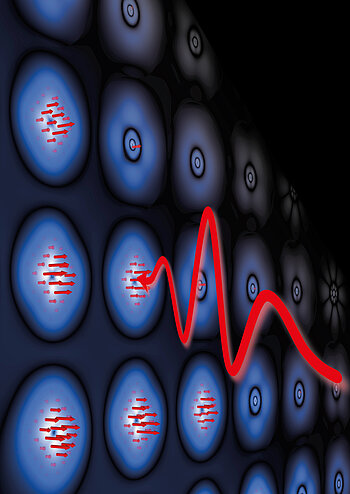The type of coupling between the constituent atoms of a magnetic solid, usually ferromagnetic (FM, i.e. with parallel magnetic moments on neighboring atoms) or anti-ferromagnetic (AFM, anti-parallel orientation), is a fundamental property of any magnetic material. This coupling is governed by the exchange interaction between the electrons on the neighboring atoms. For a typical magnetic material, the timescale associated with this interaction is of the order of a few 100s of femtoseconds. In earlier theoretical work [1,2] it was predicted that it is possible to control magnetization via light pulses even at sub-exchange time scales of the order of few tens of femtoseconds. This includes changing the magnetic order from AFM to FM in materials that consist of different types of atoms, forming so-called sub-lattices in the solid. The electrical field of the light pulse was found to induce an electron and associated spin current flowing between the sub-lattices, leading to a transient change of the magnetic order. Furthermore, it was seen in theory that this optical inter-site spin transfer (OISTR) dominates the early time spin-dynamics in all multi-sub-lattice magnetic materials, followed by spin-orbit coupling mediated processes at slightly later times.
Light wave dynamic control of spins
This understanding of the fundamental processes occurring during and after illumination of a magnetic material with a laser pulse could now be tested experimentally, investigating a material system that looked particularly promising in the theoretical calculations carried out in the Group of Sangeeta Sharma at the Max Born Institute. A consortium of researchers from the Max Planck Institute for Quantum Optics and for Microstructure Physics, the Max Born Institute, the University of Greifswald and Graz University of Technology were able to manipulate the magnetic properties of Ni/Pt multi-layers on a time scale of electrical field oscillations of visible light – and thus in sync with the electrical properties – by means of a few cycle laser pulse. As predicted, the material composed of Ni and Pt sub-lattices changes its magnetic state already in less than 10 femtoseconds. Furthermore, the response is synchronous with the electric field present when the ultrashort laser pulse hits the magnetic material and redistributes electrons between Ni and Pt atoms.
This result underlines the importance of the OISTR mechanism and constitutes the fastest manipulation of the magnetization of a material so far. It lays a foundation for an improved, coherent control of magnetic properties based on light pulses in suitably designed materials, which may be exploitable technologically in the future.
1. J. K. Dewhurst, P. Elliott, S. Shallcross, E. K. U. Gross and S. Sharma
Nano Lett. 18, 1842, (2018)
2. J. K. Dewhurst, S. Shallcross, E. K. U. Gross and S. Sharma.
Phys. Rev. Appl. 10, 044065 (2018)
Search publications of MBI
Publications since 2025
